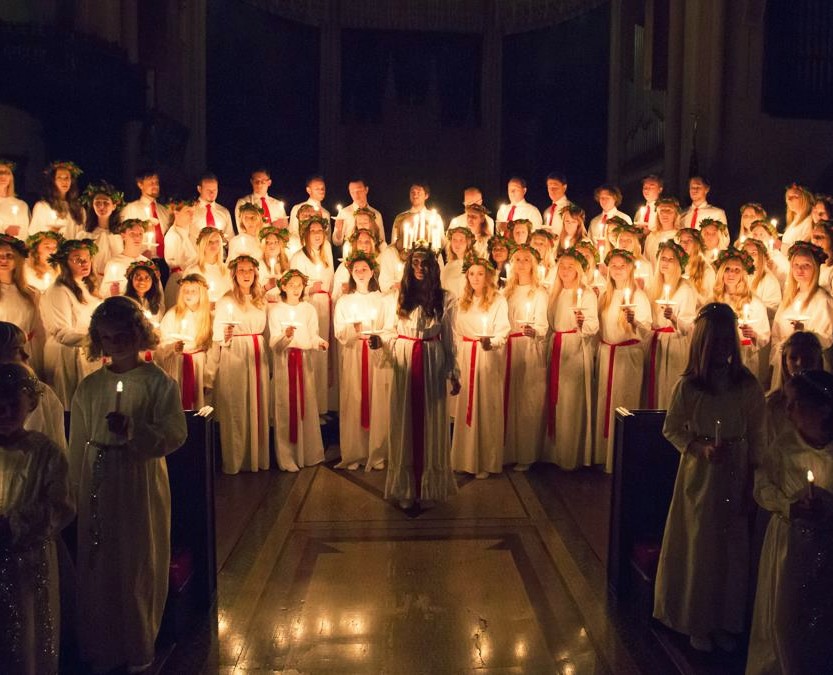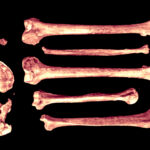How dark the night is in midwinter,
but then see Lucia is now approaching.
She brings, the good one, the light here,
she comes with a greeting about Christmas peace,
she comes with candles in her crown.
This is the first verse in the song Lucia – så mörk är natten (Lucia – How dark is the night), one of the songs that is sung during the Swedish celebration of Lucia. She comes early in the morning, accompanied by her trail of maids and star lads, to enter buildings and churches all over Sweden on the 13th of December every year.
The celebration of Lucia (Saint Lucy) is a most beloved tradition in Sweden and, together with advent, is part of the build-up for the Christmas celebrations. Lucia is the bringer of light in the darkest of hours, and her presence on the 13th of December is a mixture of traditions from before and after the Christianization of Scandinavia.

Lucia as a modern celebration takes place mainly in the mornings but can occur throughout the day as well. Before Lucia arrives, everything is peaceful and quiet, yet with a sense of anticipation in the air. The light is dimmed, and everyone at the building awaiting Lucia has gathered in their designated collection hall. During the Lucia event, people can have a morning fika (a get-together with hot beverages and sweet breads), including glögg (sweet mulled wine) and lussekatter (a type of sweet bread spiced with saffron and raisins). Then, in the quiet and dark, singing voices arise and then lights will appear: Lucia is approaching. She is dressed in a white dress, as are her maidens and star lads. On her head she wearing a candlelit crown decorated with lingonberry sprigs and sometimes red ribbons. Her maidens have wreaths in the same manner but with no lights, and the star lads have white paper cones decorated with golden stars on their heads. Everyone is holding a lit candle in their hands, and Lucia and her maidens have a red ribbon tied around their waists.
They sing Christmas songs and brighten up the mood for everyone attending. It is truly a magical moment.
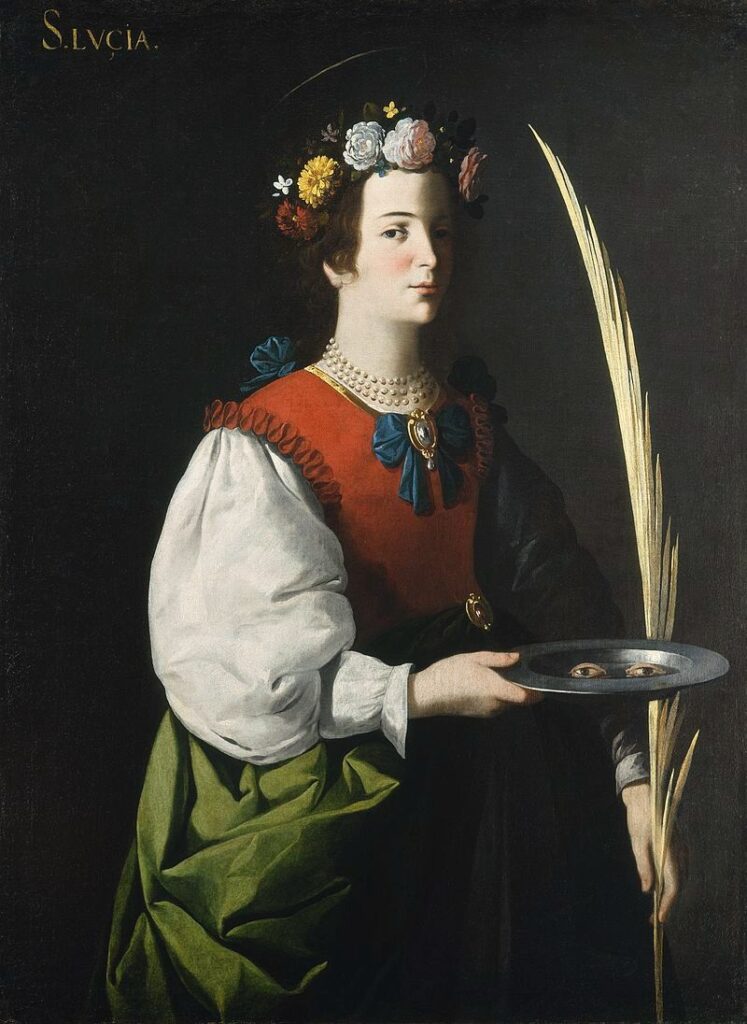
But who is she, Lucia? Lucia was a Christian woman who lived in Sicily between c. 283-304 AD. She was born into a rich family and was promised to be married in a match arranged by her mother. However, Lucia had made a vow of chastity she had not told anyone about. She managed to persuade her mother to break the engagement, but her ex-fiancé was not happy with this. He felt cheated and reported Lucia to the Roman emperor Diocletian, who persecuted Christians as the faith of Christ was yet forbidden. Lucia was sentenced to become a prostitute at a brothel, but when they came to get her, they were not able to move her. Then they tried to burn her at a stake, but no flames could touch her. Eventually, a soldier pierced a lance trough her neck, of which she died on the 13th of December. For her death as a martyr, she was made a saint, and remains to this day the protective saint of Syracuse. She is also said to have pierced out her own eyes to give to an admirer, after which she was given new eyes by God. She is therefore sometimes depicted holding a tray with her eyes on them.
But how did a Sicilian saint become part of one of Sweden’s most beloved holidays?
Lucia, in the Swedish tradition, has little to do with the saint’s own culture; the celebrations of December 13th date much further back than the name. It was not until the early 20th century that Sweden established the uniform, nationwide holiday called Lucia on that date; before that, the celebration on the 13th was very diverse over Sweden. But the date itself has been crucial in the Swedish calendar since time immemorial.
The reason for this is because going by the old Julian calendar, December 13 was the darkest night of the year—the eve of the winter solstice. This, however, changed after the calendar reformation in 1753, when the Gregorian calendar was put into use in Sweden, and the winter solstice shifted to December 21. But the folk tradition still stood—the night before the 13th was still popularly known as the darkest night, and therefore also the most dangerous, for the darkness allowed evil entities to thrive longer than any other night. This, in turn, has led to a number of traditions, but the most important aspect has always been the one of light and feasting. To keep the evil away, it was important to stay awake and to stay indoors with lights. But to be able to stay awake a whole night, one must eat. Tradition decreed that almost all preparations for jól (the midwinter celebration) should also be completed by the 13th, including the slaughter of the festive pig, meaning there was fresh food prepared already and the long night served as a good reason to get an early start on the seasonal feasting. Sometimes, the teenagers and young adults would walk from neighbor to neighbor, singing songs in exchange for food and drink, protected with light. Sometimes they would dress up, and sometimes they would do some pranks to scare people.
Today, the tradition is still standing: to lussa is to dress up as Lucia and walk to neighbors or family members with song and cakes. However, the act of lussa was origianally to stay awake during the night between the 12th and 13th and was called Lussevaka (Lusse watch). Lucia can still be equally called Lussefirande (Lusse celebration) today.
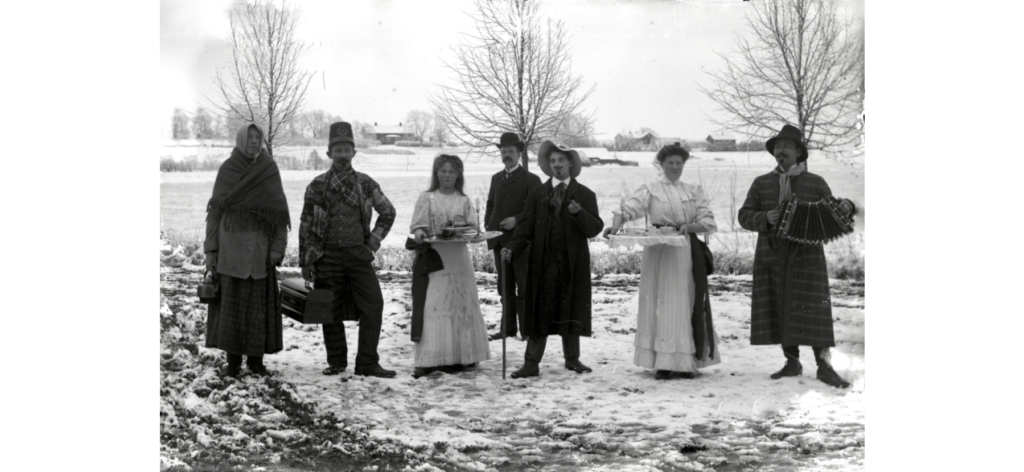
But why Lussa? Lussi, otherwise known as Lussekäringen (the Lussi witch) or Lussegubben (Lussi man), was an evil entity. She often took the form of a woman who came riding through the skies with her companions called lussifreda. She was one of the evil spirits who would lurk around in the night and take naughty children away through the chimneys, or punish those who had not completed their jól preparation.
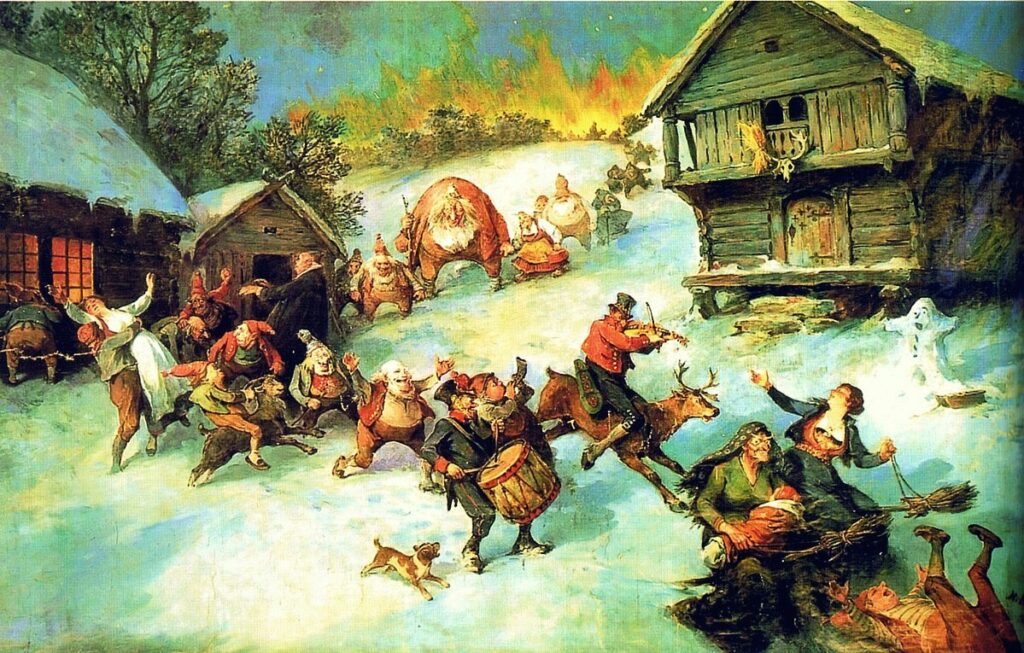
And it is due to this, in the dark of the longest night with a despair for light, with evil all around, that the myth of a female figure of light arose. During the pre-Christian era, the light was sworn to keep evil away. The tradition of a light-bringing woman may therefore have its foundation in a heathen goddess of light who was invoked during this night. The tradition of celebrating light in this manner through Lussevaka has stayed on in different forms ever since.
In the 19th century, a special interest sparked in the Lusse celebration, due to the first wave of nationalism and the search for old folk traditions all around Sweden. Lusse, which was mainly celebrated by men or women dressing up in white with a crown of flowers, holding candlesticks and walking around the farm with food while singing in the morning, gave the foundation to the modern Lucia. There are several accounts from this period of different versions of what would be interpreted as a Lucia, even some where she is the one to bring the gifts for Christmas. The tradition with dresses and candle crowns is also believed to stem from 18th century Germany and their celebration of Christkindlein, in which a girl was dressed up to represent Christ, the candles being a symbol of the gloria.
The tradition of a white-dressed woman with lights came to be popular in the upper-class environments. Nobleites and burgees caused the tradition to spread over Sweden as a trend and soon students picked up on this celebration.
But how did Lucia, the virgin saint, come to be connected with the singing light-bearer of Sweden? Well, it is said in Sweden that Lucia was a patron for the poor in need. In Roman times, she would sell her jewelry to buy bread for the Christians who hid in the catacombs. To be able to carry all the bread, she would make a crown of lights to put on her head, leaving both her hands free to carry and distribute food—it was this similarity with food and light that led to her connection with Lusse as well as her day of death on the 13th December. One further addition from the Lucia story is the red sash tied around the modern Lucia’s waist, representing the blood that spilled from her when she was killed by the Roman soldiers. From these beliefs stems the tradition of Lucia today.
To celebrate Lucia, or to Lussa, is a long and diverse tradition, but what keeps it together through centuries is the celebration of light, the wait for Yuletide, and the community amongst loved ones and neighbors: to endure the darkness together so we can embrace the light together.
Text: Lovisa Sénby Posse. Copyright 2021 Scandinavian Archaeology.
Cover Photo: Svenska Kyrkan.
Further Reading:
https://kvallsstunden.se/vitkladd-med-ljus-i-har-varfor-da/
https://www.nordiskamuseet.se/aretsdagar/lucia
Alver, B. 1976. Lussi, Tomas og Tollak: tre kalendariske julefigurar
About the author
Iron age Scandinavian archaeologist with a bachelor in Liberal arts with major in Archaeology and a bachelor in Art history with major in Nordic art, both from Uppsala University, Sweden. Exchange studies at Trinity College, Dublin, Ireland, and University of Pretoria, Pretoria, South Africa.
Master of Arts (two years) in Archaeology with specialization in burials, ship burials, and artefact management and interpretation, also from Uppsala university, Sweden.
In my master thesis I created an analyzing method to handle large quantities of artefacts, a method descended in Art History. I also created a method with elements of theory to perform a spatial analysis on graves. This also derived from Art History. The methods were applied to ship burials at Valsgärde, Upland, Sweden.
As Editor-in-chief, I am responsible for the publication and over all work with Scandinavian Archaeology, a job I deeply enjoy. I also founded the magazine in late September 2020.
